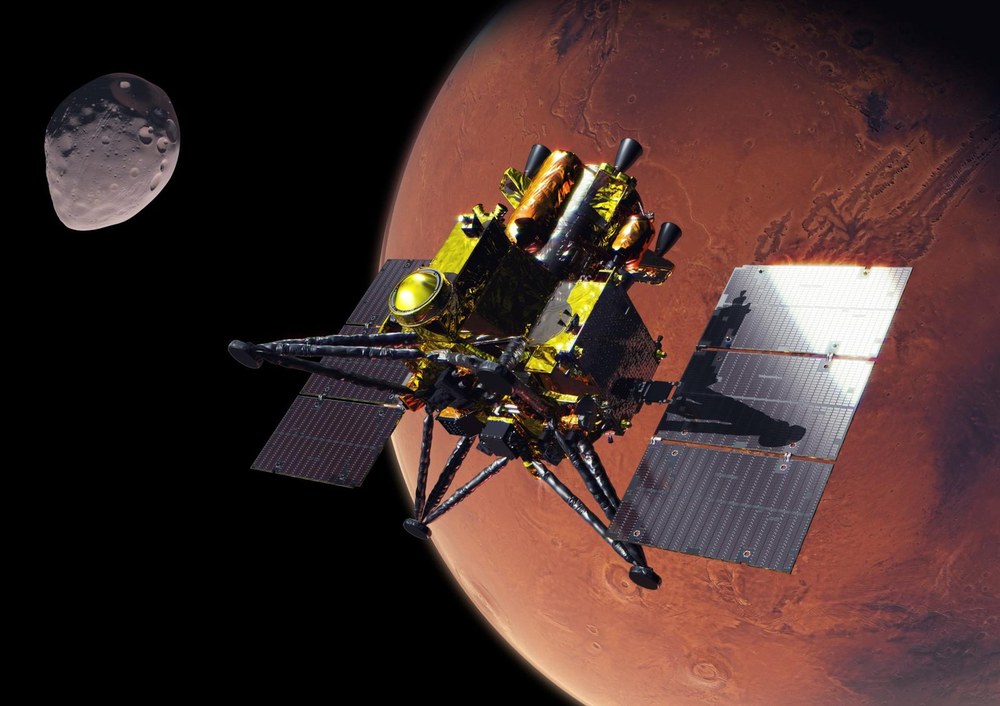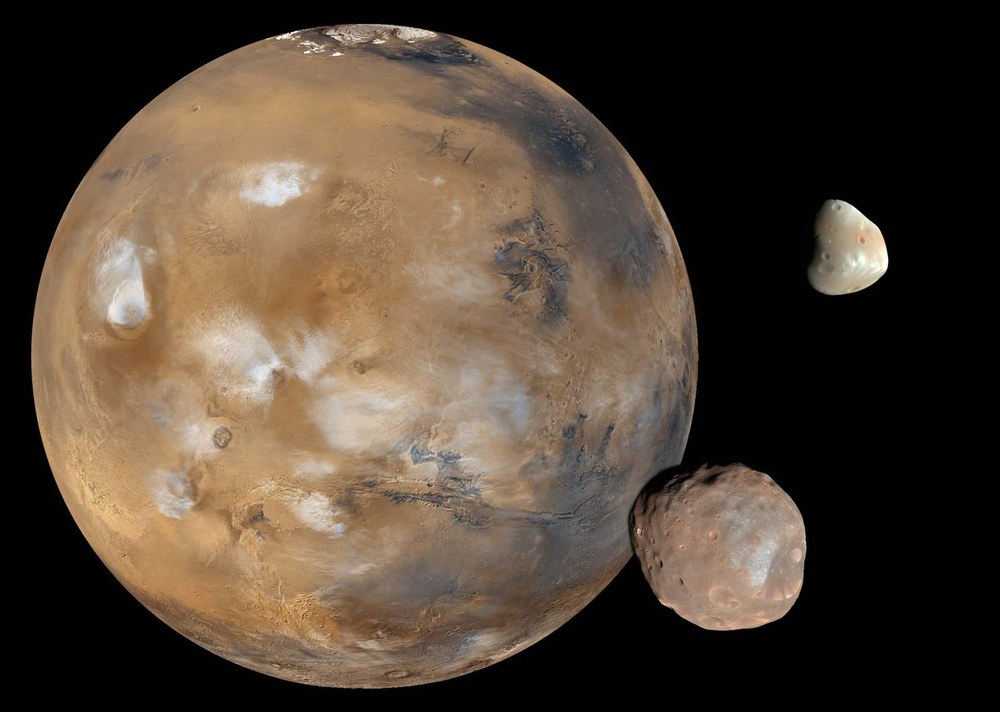The aim – Phobos and Deimos


Phobos and Deimos – these names from Greek mythology were given to the moons of our neighbouring planet Mars, discovered in 1877 by the US astronomer Asaph Hall. Besides Earth's Moon, they are the only two natural satellites in the inner Solar System. They are much smaller than Earth's Moon and, due to the low gravitational forces, are not spherical but of irregular shape. At its widest point, Phobos has a diameter of just under 27 kilometres, and Deimos only 15 kilometres. Telescopes on Earth are therefore not able to reveal much detail about these elusive moons. Both have been observed at close range by spacecraft orbiting Mars. However, a fundamental question remains: how did these moons form? Their spectral properties are similar to those of asteroids and different from those of Mars. With the Martian Moons eXploration (MMX) mission, researchers hope to find an answer.
No moon lasts forever
Phobos completes one orbit of Mars in just over seven and a half hours at an altitude of approximately 6000 kilometres. Thus, the moon moves around the planet faster than the planet rotates: one Mars rotation takes it a little more than 24.5 hours. As a result, an astronaut on Mars would see Phobos rising in the west and setting in the east. Deimos orbits Mars at an altitude of approximately 23,500 kilometres and has an orbital period of just over 30 hours. No other moons in the Solar System orbit their planet at such low altitudes.
Measurements made using instruments on spacecraft, including DLR's High Resolution Stereo Camera (HRSC) on ESA's Mars Express orbiter, have shown that Mars exerts tidal forces on the two small bodies that alter their orbits. Just as our Moon is slowly but steadily moving away from Earth, Deimos is moving ever farther from Mars. In the distant future, Deimos will probably be lost to the Red Planet. Phobos, meanwhile, is slowly approaching Mars in a spiral orbit and will probably see it break up when it reaches an altitude of 5500 kilometres. This is the altitude of the Roche limit at Mars, within which the tidal forces will exceed the moon's internal cohesion and Phobos will be torn apart. This is expected to happen in approximately 40 million years. The resulting rocky debris will probably form a temporary ring around Mars.
The first close-up images of the martian moons were sent to Earth by NASA's Mariner 9 spacecraft in 1972, followed by images from the two US Viking orbiters from 1976 to 1980. Then came photos and measurements acquired using NASA's Mars Global Surveyor, Mars Reconnaissance Orbiter and 2001 Mars Odyssey, and ESA's Mars Express spacecraft. The USSR, and later Russia, developed three missions exclusively for the study of the martian moons: Phobos 1 and 2 in the late 1980s, which saw radio contact break off after arriving at Mars after transmitting only a little data, and the Phobos Grunt mission launched in 2011, which was lost in Earth orbit shortly after launch. Accordingly, although Phobos and Deimos have been photographed, measured and had their geological, mineralogical and geochemical properties characterised to a certain extent, they still remain relatively poorly understood to planetary researchers.

Video: Occultation of Deimos by Phobos
Your consent to the storage of data ('cookies') is required for the playback of this video on Quickchannel.com. You can view and change your current data storage settings at any time under privacy.
ESA/DLR/FU Berlin – CC BY-SA 3.0 IGO, K.-D. Matz
Competing formation theories
There are two central questions surrounding Phobos and Deimos: 'How did they form?' and 'What are they made of?' Both bodies are extremely dark. They reflect only five percent of the sunlight that lands on them and resemble charcoal. Mars, on the other hand, reflects almost four times as much sunlight on average. This makes it difficult to explain a common origin for the planet and its moons. Nevertheless, this explanation is still one of three currently being considered: either the moons are asteroids captured by Mars' gravity, they were formed from ejecta resulting from a powerful impact on the planet's surface, or they formed at the same time as Mars.
In favour of the 'capture theory' is the fact that the colour spectra of both moons resembles that of 'D-class' asteroids: they are just as dark, homogeneously reddish, low in water and rich in silicates and molecules containing carbon. The asteroid moons could perhaps even originate from beyond the orbit of Neptune. Arguments against this model include the fact that both moons orbit Mars close to the ecliptic, the plane in which all planets and most of their moons move around the Sun and that their orbits are almost circular. This would be a difficult coincidence to explain in the case of captured asteroids. Instead, their orbital parameters are good arguments in support of the third theory – that the moons formed at the same time as Mars. However, one fact that speaks against this theory is that the specific density of the moons, at 1.87 grams per cubic centimetre, is less than half that of Mars.
Recent investigations suggest that the moons may be the remains of a large impact that took place while Mars was still very young – an impact that may have also created the planet's extensive northern lowlands. The impacting body could have been up to 2000 kilometres across and knocked trillions of tonnes of bright crustal rocks and dark mantle material out of the young planet. This debris would have then formed a ring around Mars that eventually coalesced into Phobos and Deimos. There could have even been other moons that were then lost to Mars or returned to the planet in later impacts. This theory would explain the almost ecliptic and circular nature of the moons' orbits quite well.
MMX mission timeline
In-situ exploration will be vital for determining the origins of Phobos and Deimos and for improving our understanding of the role that small bodies play in the development of the planets in general. JAXA's MMX will be its third mission, after the two Hayabusa missions to the asteroid belt, to acquire samples from distant bodies and transport them to Earth. The US space agency, NASA, the European Space Agency (ESA), the French space agency, CNES, and DLR are also involved in the mission.
The MMX spacecraft will observe Phobos and Deimos from orbit from 2027. During the initial observations a suitable landing site will be sought for both the mother ship and the small MMX rover. The rover will offer a mobile exploration of the surface of Phobos using a host of scientific instruments. DLR played a major role in developing the rover's radiometer and Raman spectrometer. Later in the mission, samples will be collected, which are expected to arrive on Earth in 2031. Regardless of how Phobos and Deimos formed, it is likely that material from Mars was hurled at Phobos during later impacts. As a result, the samples from the moon will also likely contain traces of the planet. If this proves true, MMX would then also be the first mission to return samples of the martian surface to Earth.
MMX – Martian Moons eXploration
MMX is a mission of the Japanese space agency JAXA with contributions from NASA, ESA, CNES (the French space agency) and DLR. CNES (Centre National d'Études Spatiales) and the German Aerospace Center (Deutsches Zentrum für Luft- und Raumfahrt; DLR) are jointly contributing a 25-kilogram rover to the Martian Moons eXploration Mission (MMX). The Franco-German MMX rover is being designed and built under the joint leadership of CNES and DLR. In particular, DLR is responsible for the development of the rover's landing gear, including the lightweight body, as well as the entire uprighting and locomotion system. DLR is also contributing the connection adapter to the MMX spacecraft and providing a Raman spectrometer and a radiometer as scientific experiments. These will analyse the surface composition and texture on Phobos. CNES is making significant contributions with camera systems for spatial orientation and exploration on the surface, as well as for the study of mechanical soil properties. CNES is also developing the rover's central service module, including the on-board computer and the power and communications system. After the launch of the MMX mission, the rover will be operated by CNES control centres in Toulouse (France) and DLR in Cologne (Germany).
For DLR, the institutes of System Dynamics and Control, Composite Structures and Adaptive Systems, of Space Systems, of Optical Sensor Systems, of Planetary Research, for Software Technology and the Microgravity User Support Center (MUSC) are also involved under the leadership of the DLR Institute of Robotics and Mechatronics.
The MMX mission is a continuation of an already long-standing successful cooperation between JAXA, CNES and DLR. It builds on the previous mission Hayabusa2, in which JAXA sent a spacecraft to the asteroid Ryugu with the German-French MASCOT lander on board. On 3 October 2018, MASCOT landed on Ryugu and sent spectacular images of a landscape ridden with boulders and rocks, and virtually no dust. Hayabusa2 collected samples from Ryugu and brought them to Earth on 6 December 2020.

